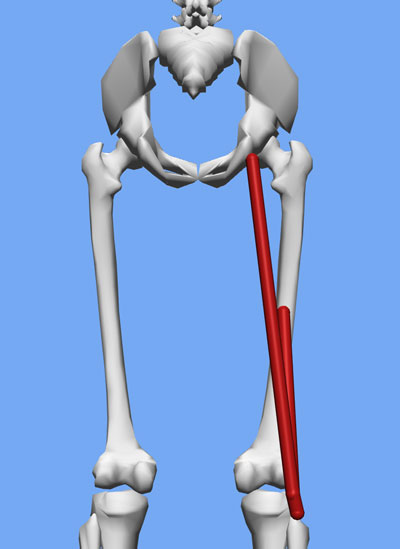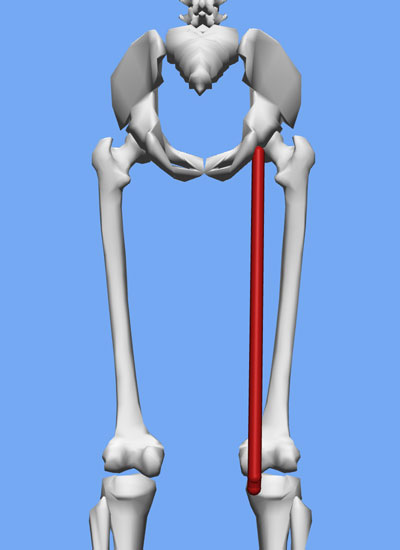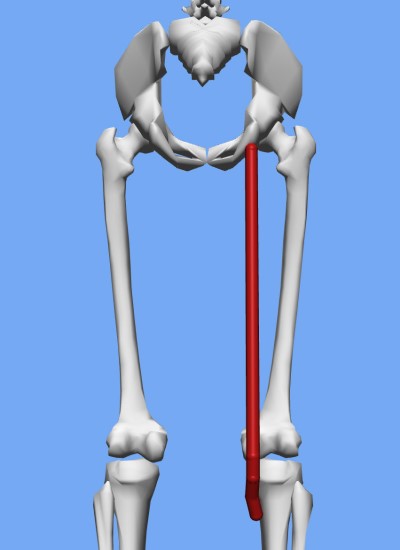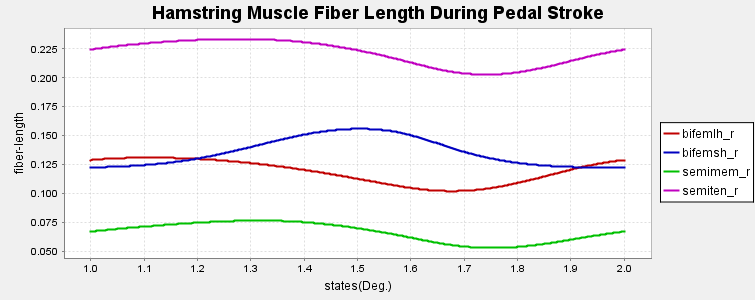How Cycling Uses The Hamstrings
Although cycling is commonly associated with big thighs and maybe even a big butt, there are other muscles engaged throughout the pedal stroke. For a rider clipped into pedals, there is an opportunity to engage the hamstrings. By pulling up on the pedals on the backside of the pedal stroke we engage the hamstrings. The hamstrings are also involved in determining a rider's saddle height. This is because an excessively high saddle position could cause pain or tendinitis in the area. Riders can also pinch their hamstrings under the saddle in some riding positions. Let's look at the hamstrings and how they fit into the sport of cycling. There are three hamstrings that connect the pelvis to the lower leg. The hamstrings are two joint muscles, but one of the hamstrings (bicep femoris) has a head that connects to only the femur, making it a one joint muscle. We'll use a few OpenSim models to visualize the hamstrings.
Hamstring Muscles



Bicep Femoris
The bicep femoris is the outer hamstring. It connects to the outside of the back of the leg just below the knee. One head connects to the pelvis and the other head connects midway up the femur. Imagine if the pelvis is held static, if the bicep femoris contracts, we can see how the knee would bend. Only bending the knee with the bicep femoris would likely cause some problems because it pulls on the outside of the knee only. We need another muscle (or two) to balance the force on the knee joint.
Semimembranosus
The semimembranosus runs down the center of the back of the leg. This central hamstring is the closest our body gets to in-plane knee bending. You can see it attaches to the tibia with a slight medial offset. For the most part we can consider this hamstring as an in-plane knee bending muscle. Typically, the semimembranosus is visible for athletes with defined leg muscles. It's the line down the center of the back of the leg.
Semitendinosus
The semitendinosus is the inner hamstring. It runs down the back of the leg, but is more medial than either of the other two hamstrings. The semitendinosus balances out the force from the bicep femoris to facilitate proper knee bending. You can imagine that if only the semitendinosus or bicep femoris is engaged, the knee joint will have out of plane pressure and the potential for pain is higher at the knee joint.
Hamstring Overuse and Soreness
So far I've been focused on the importance of the hamstrings in knee flexion. That's because the hamstrings are the main muscle group for knee flexion. As stated before, the hamstrings connect directly to the pelvis. As a result, we can actually induce hip extension by engaging our hamstrings. Although the hamstrings have less mechanical advantage compared to the glutes for hip extension, if the femur moves backwards towards the butt, we see a decrease in length of the hamstring muscle fibers. For exercises like deadlifts which has significant hip extension, the hamstrings will engage and help produce force for the movement. In some athletes, the hamstrings are overdeveloped compared to the glutes. As a result, tasks typically assigned to the glutes may be co-opted by the hamstrings. There are two issues with this:
- The hamstrings lack the mechanical advantage of the glutes to produce force with hip extension
- The gluteus maximus is the largest muscle in the body and can produce lots of force
Expecting a smaller muscle group to accommodate the same tasks is asking for overuse, fatigue, and potentially more serious injury.
Does Cycling Use Hamstrings?
It's undeniable that hamstrings change length during the pedal stroke. Any movement of the knee joint will cause hamstring length changes, but a more interesting question is: Are the hamstrings actively engaged during that movement pattern? There are a
Hamstring Use in the Pedal Stroke

This chart shows the length of the hamstrings for a single pedal stroke starting at 12 o'clock. It's clear that, except for the short head of the bicep femoris (bifemsh_r), there is significant change in muscle fiber length on the backside of the pedal stroke between 6 o'clock and 9 o'clock. Because the short head of the bicep femoris only connects across the knee, its muscle fiber length pattern differs from the other hamstrings whose length is affected by the rider's hip extension when cycling.
Cycling with Strained or Injured Hamstrings or for Rehabilitation
A question that is often asked is whether it's OK to cycle with a hamstring strain or injury. Because I'm not a doctor, my first recommendation is always to check with a physical therapist or other licensed medical professional for their recommendations. Hamstring injuries can be complicated. Furthermore, the full extent of the injury isn't known except to the medical professional you are working with. With that being said, it's usually a good bet to only ride if you are pain free doing so. If you have hamstring pain up by the bottom of the butt, the issue may be related to dysfunction in your external rotators. These muscle groups overlap and interweave. As you can imagine, a tight muscle in your lower butt pushes other muscles out of their normal firing path, pinches nerves, and disrupts your normal motor patterns. Again, a medical professional is best equipped to help with these issues. If you are having some pain when you ride, you may be interested in dynamic stretching before riding to increase flexibility.
Stretch Your Hamstrings to Improve Your Cycling
As we noted earlier, there are three hamstrings and if we want to make sure they are all stretched and healthy, it may be optimal to focus on each of them one at a time. Specifically, if you open your hip out to the side, the bicep femoris is shortened relative to the other two hamstrings. We can take advantage of this phenomenon by using hip abduction and adduction to control which hamstring muscle will be stretched. As always, start slowly and in a controlled manner, attempt to find a nice, gentle stretch in each of your hamstrings. Steps to stretch your hamstring:
- Find a low box; 18 inches is a good bet.
- Keeping hips square and pelvis facing forward, lift your heel onto the box
- With a slightly bent knee, rotate the pelvis forward to lengthen the hamstrings.
- After holding for 30 seconds, abduct or adduct to address the semitendinosus or bicep femoris, respectively.
It's so common for athletes to stretch their hamstrings with their pelvis out of plane or with contortions such that they only ever stretch one of their hamstrings. The result is two of their three hamstrings have insufficient length and function. I would encourage you to think of your hamstrings as separate muscles that all need to be addressed individually.
Conclusion
Proper hamstring function is important in cycling. Even if the hamstrings are not a major force producer, their proper function is important to a healthy and pain free cyclist. As mentioned in the article, the hamstrings can be used for cycling when the glutes are underdeveloped. I wrote a separate article on which may be beneficial.